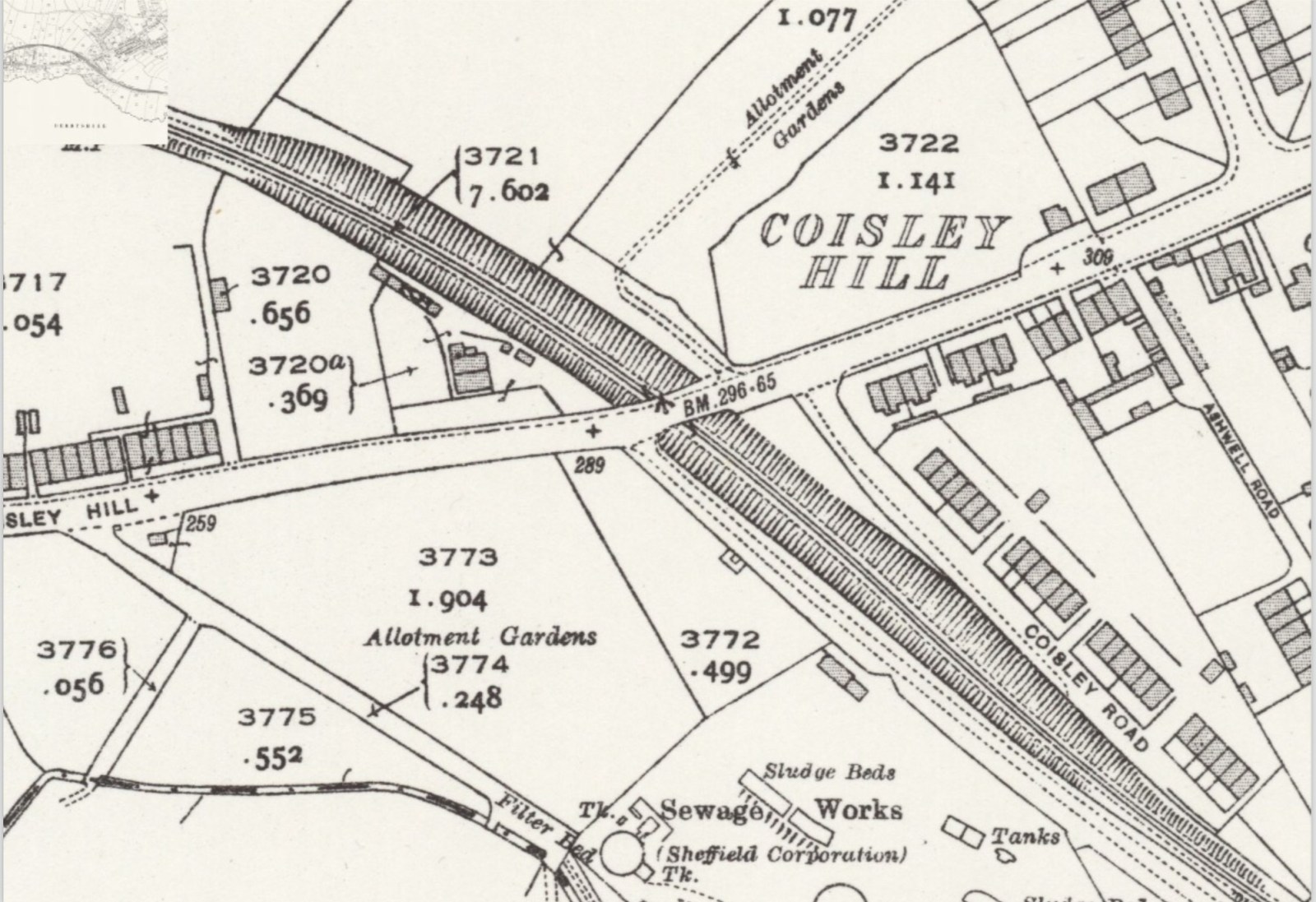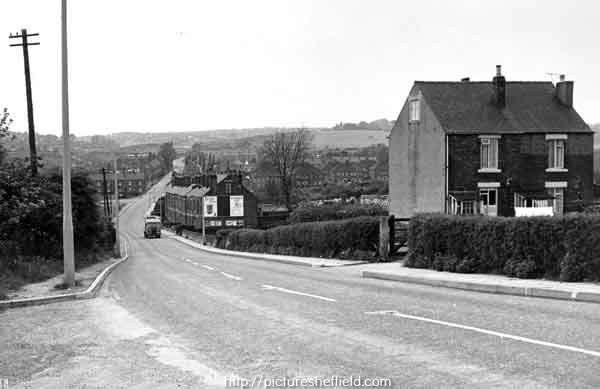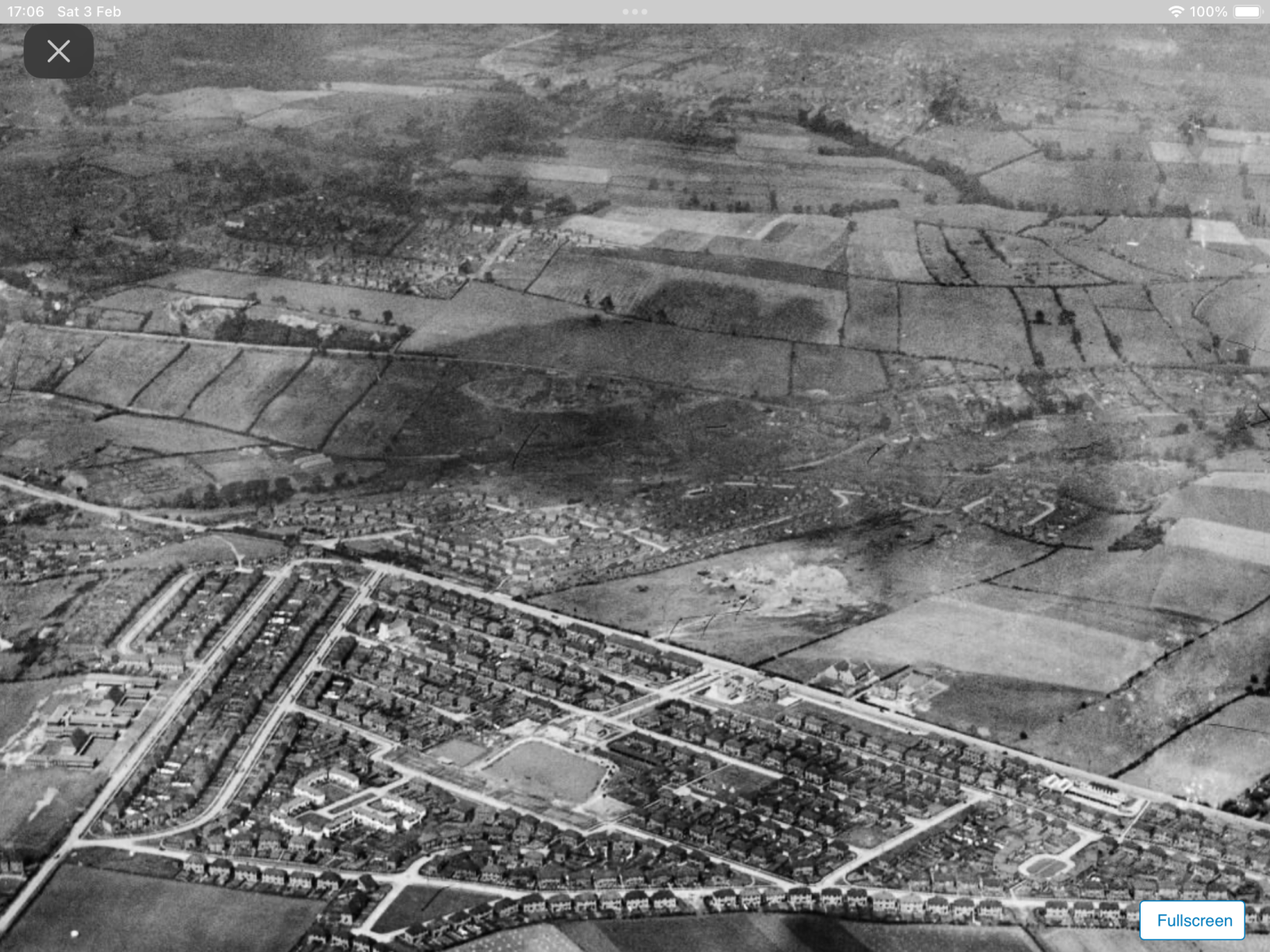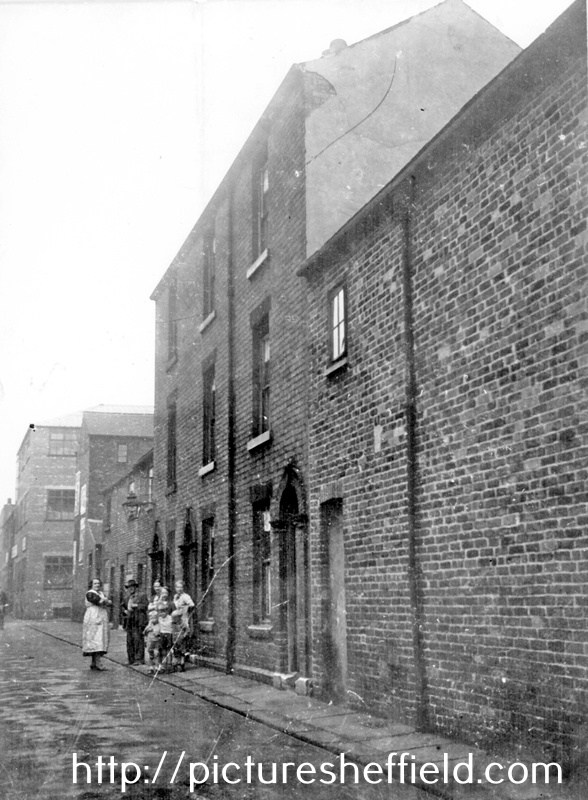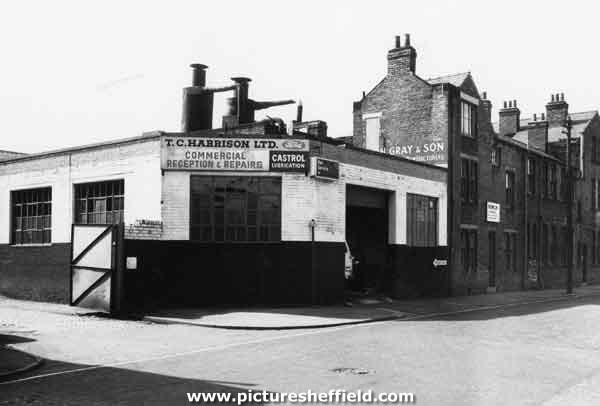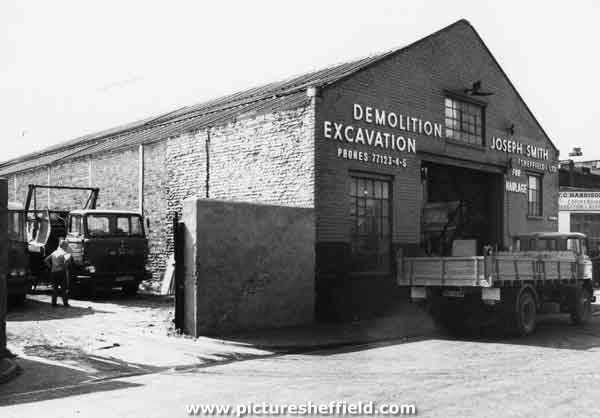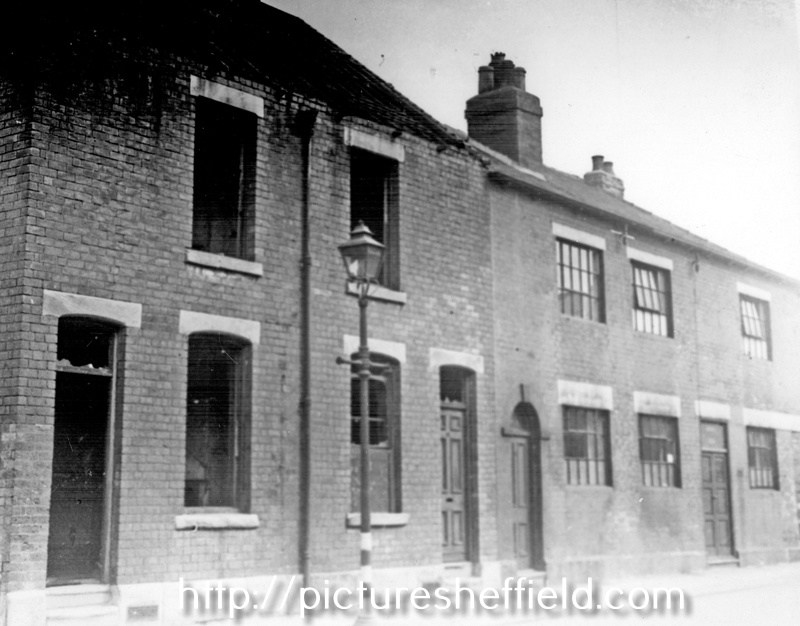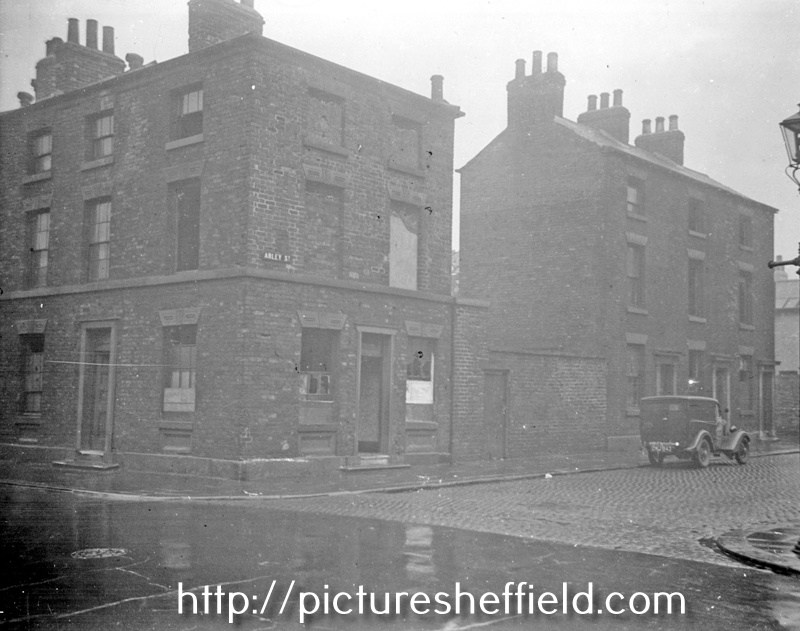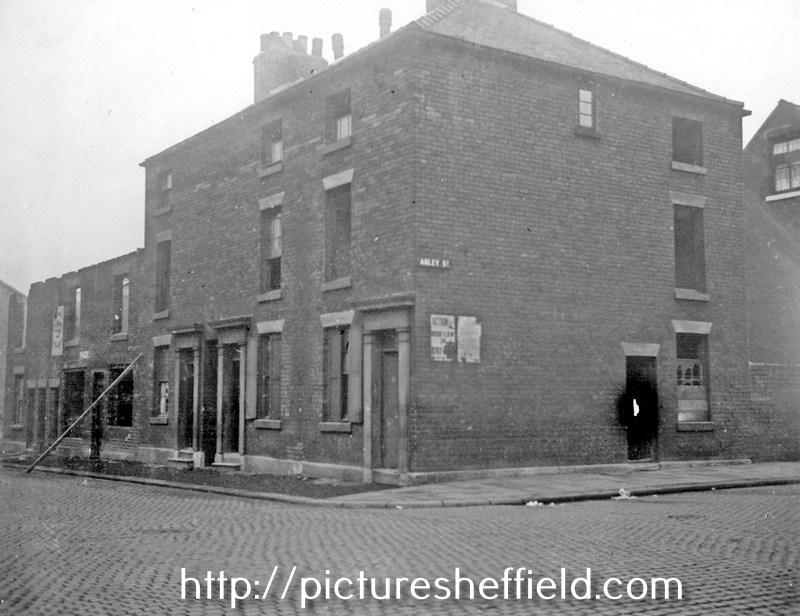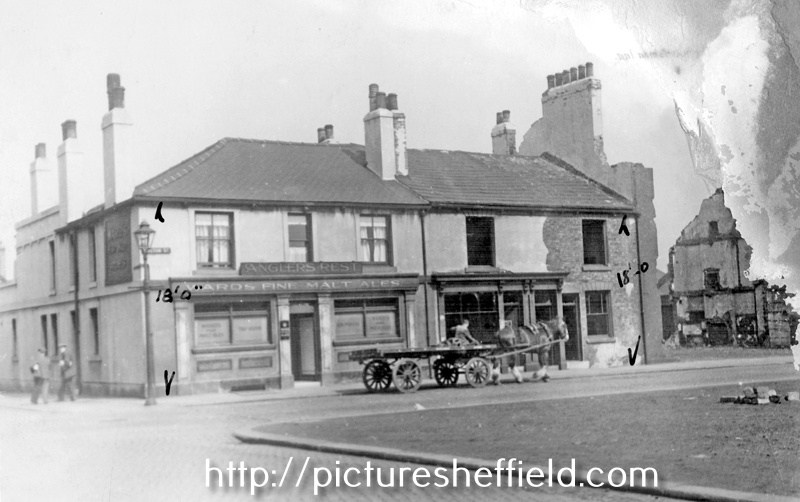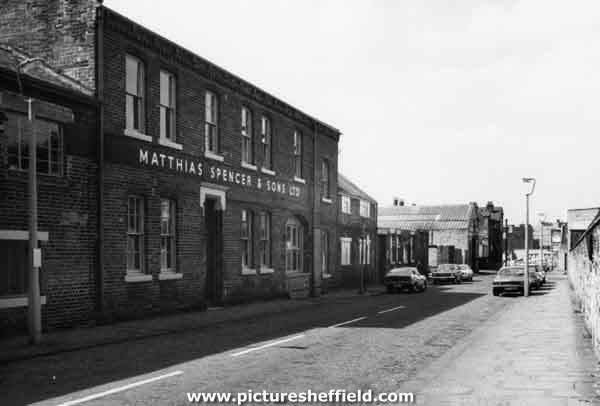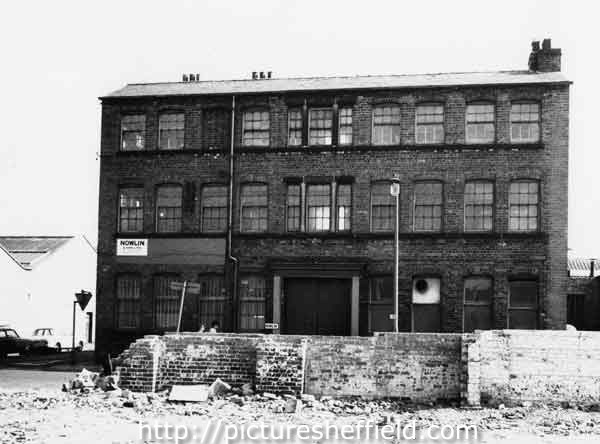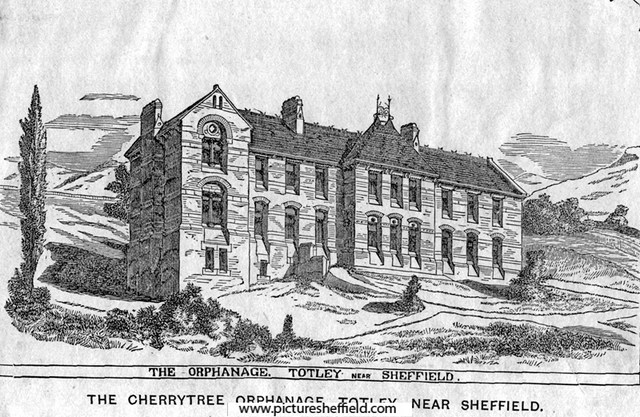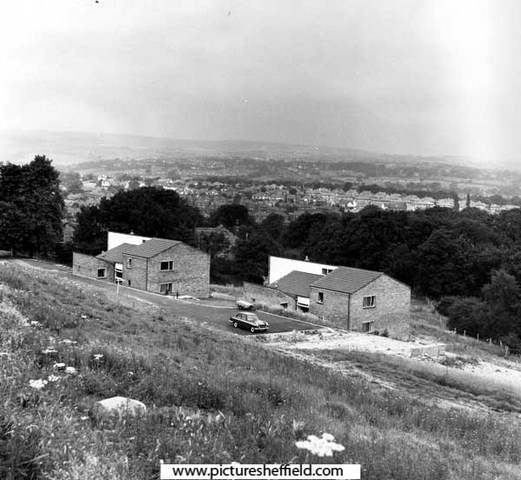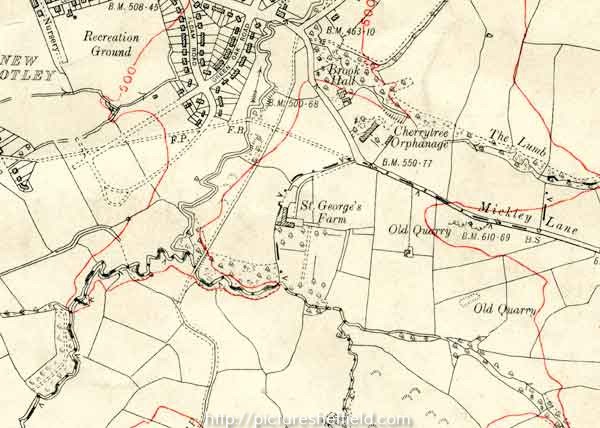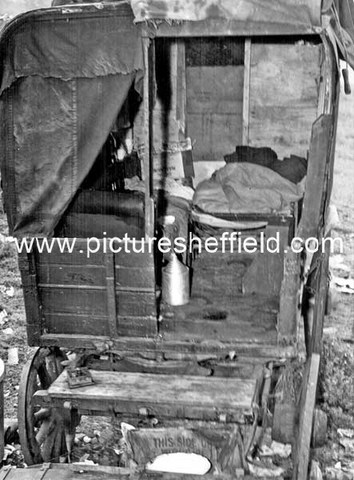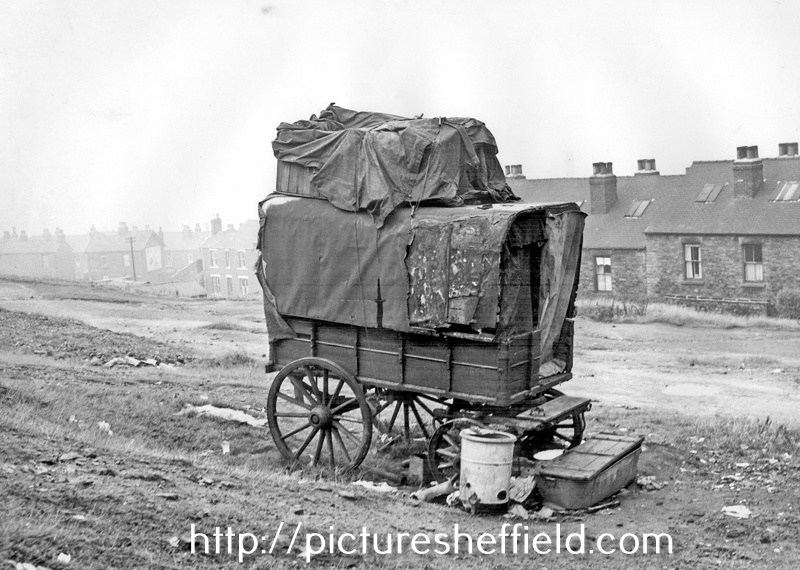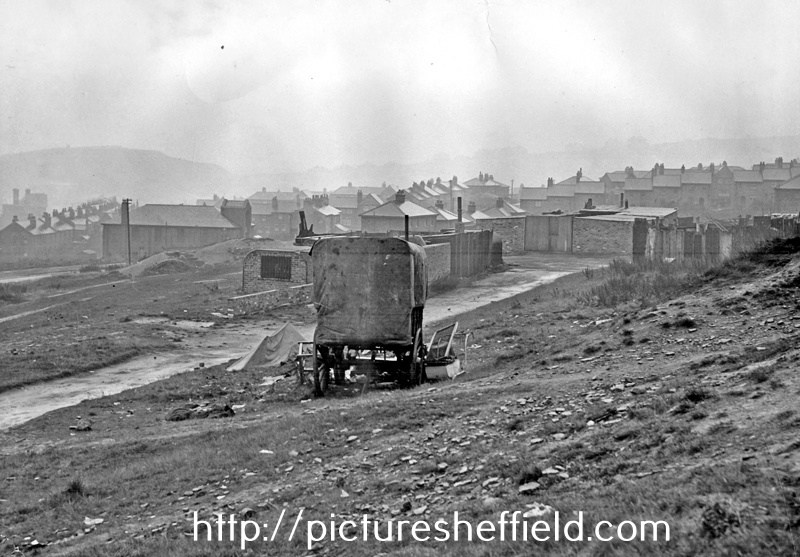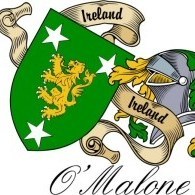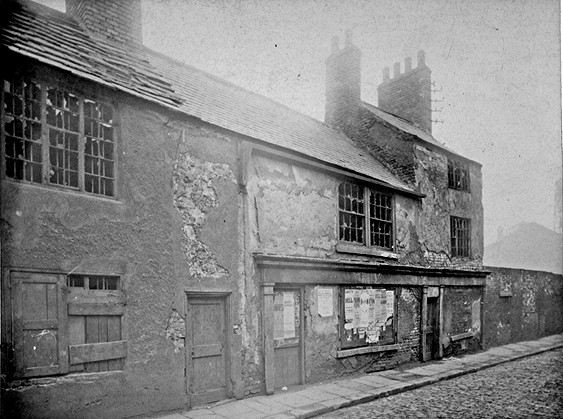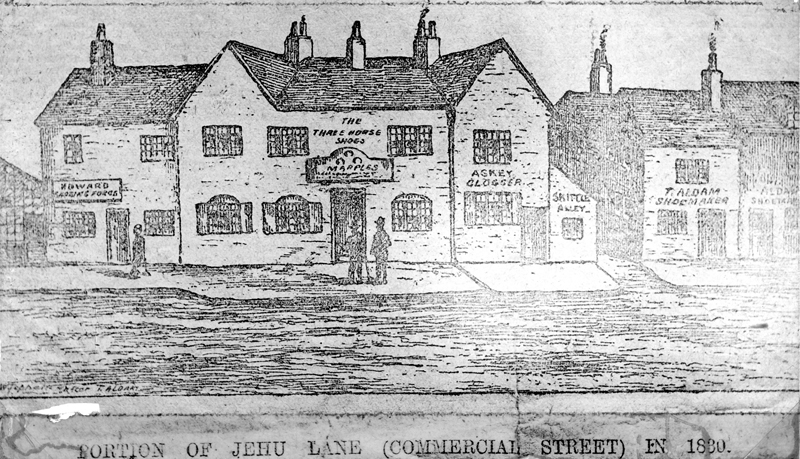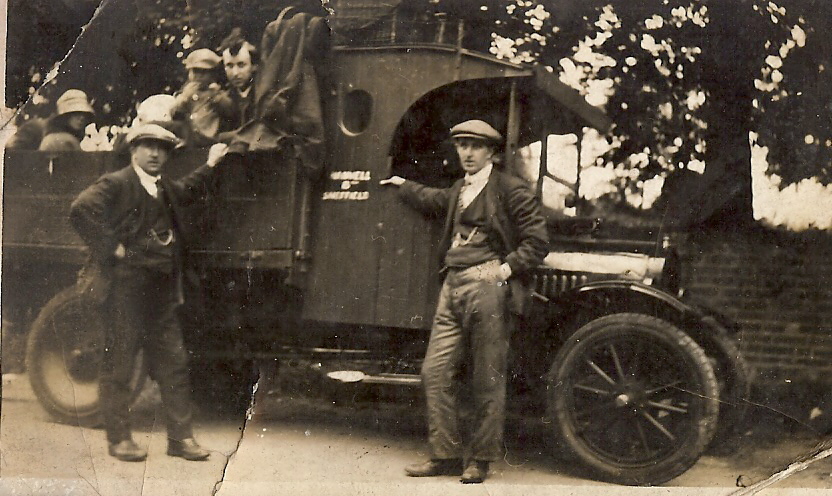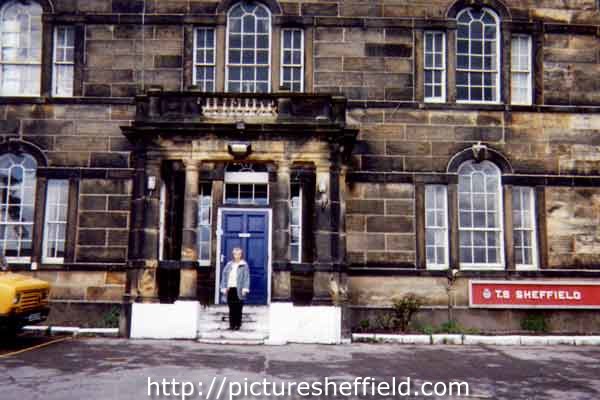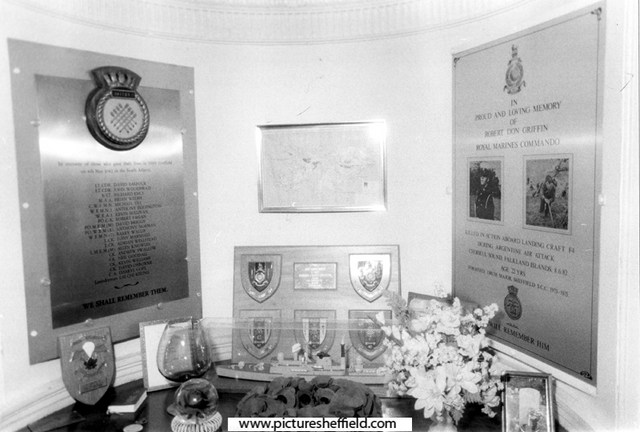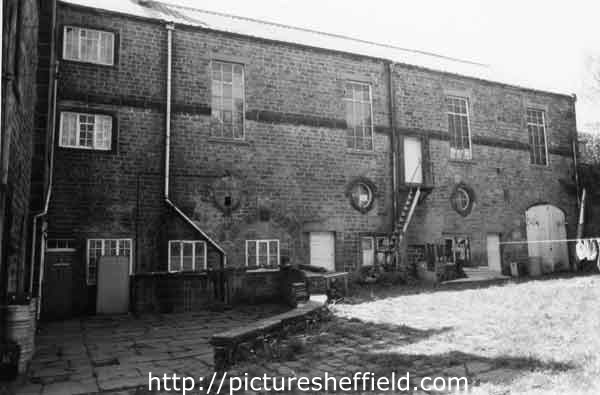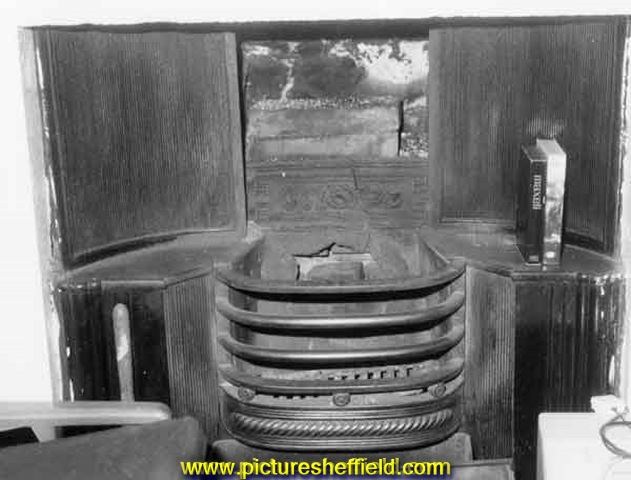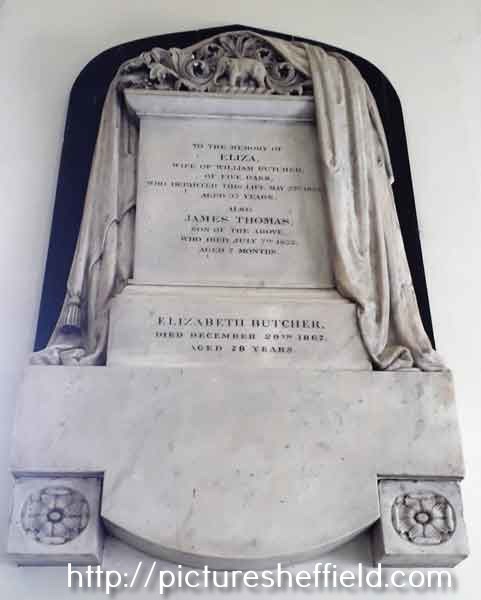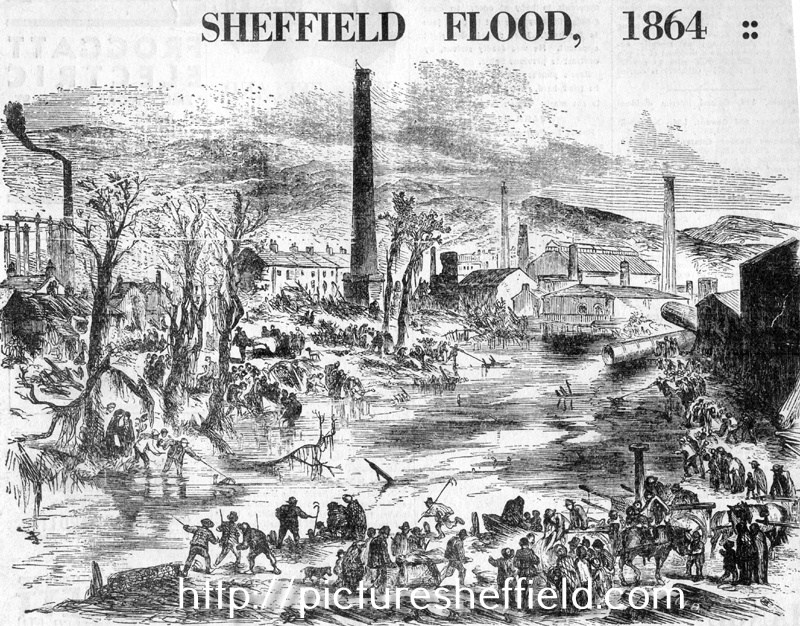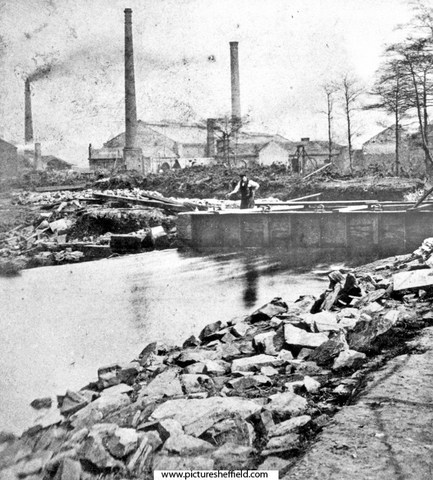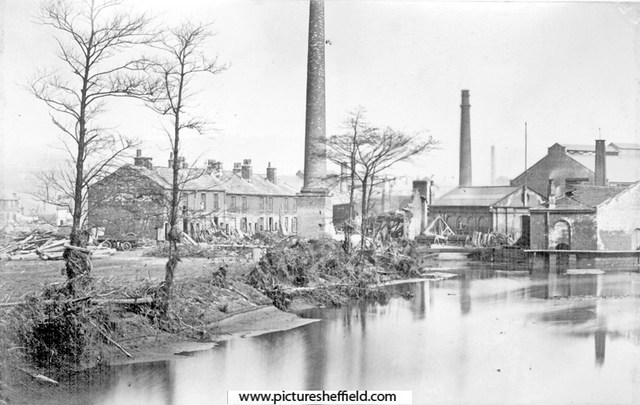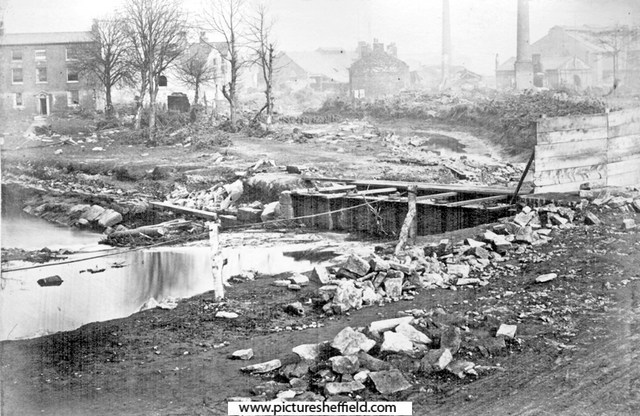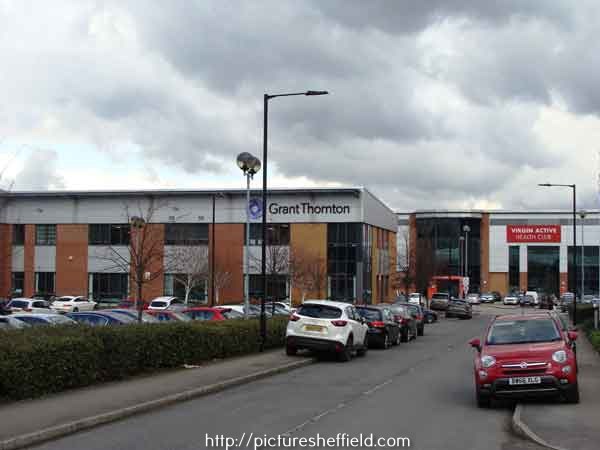Search the Community
Showing results for 'coal pit lane'.
-

Birley Collieries Branch Line
RLongden replied to Paolo Coopio's topic in Sheffield Buses, Trams and Trains
Yes you’re right, the line was in a cutting as it went under Coisley Hill, as you can see from the map detail https://maps.nls.uk/view/125651476 Also, you can see in the image, the photographer must have been stood on the pavement on the bridge, with Stone Lane to their left and the two cottages on the right… the rail line is just out of shot on the right. https://www.picturesheffield.com/frontend.php?keywords=Ref_No_increment;EQUALS;s43471&pos=11&action=zoom&id=85665 An aerial view from 1939, taken over Frecheville, looking over towards Stradbrooke Road, you can see Birley West Colliery in the junction of Linley Lane and Normanton Hill. The rail line passes under Normanton Hill, curves right in an arc, through the fields and it disappears off the right edge of the page, before it crosses Coisley Hill. https://www.britainfromabove.org.uk/en/image/EPW062831 Amazing really that roads and houses have encroached on the area, yet the route it still visible today 😁 -
Hi Can anyone point me in the right direction to obtain a map of Sylvester Lane in 1880s? Ideally with the court/house numbers. Thanks in advance A
-

New Era Square off London Road - what used to be there?
Ponytail replied to Sheffield History's topic in Sheffield History Chat
Derelict properties, Denby Street (formerly New Thomas Street) and Arley Street junction. 1937. s14851 Estates Surveyors Dept Nos 18-22, George Lane, Highfield looking towards Arley Street junction. Court Nos 3 and 5 at rear of these properties. September 1938.s16228 Estates Surveyors Dept. Nos 3-7, Arley Street (formerly Cross George Street) at junction of Nos 49-51, Hermitage Street. September 1938. s13025 Nos 17-23, Arley Street at junction of Sheldon Street. Nos 21-23, August 1943. Premises of Philip Sunderland, Silver Plater. Court No. 9 (Boston Street) at rear of houses on left. 23 Arley Street was the Grey Horse Inn. u00962 City Engineers Dept. Angler's Rest, No 50, Boston Street (formerly New George Street), at junction of Arley Street. Nos 44-46, prior to demolition, right. Back to back houses already demolished. August 1939. u02480 Estates Surveyors Dept T.C. Harrison, commercial vehicle repairers, Arley Street. May 1975. s34864 Joseph Smith (Sheffield) Ltd, haulage, demolition and plant hire, Arley Street frontage. May 1975.s34840 Matthias Spencer and Sons Ltd, mining machinery manufacturers, Arley Street. May 1975.s34863 H. L. Nowlin and Son Ltd, surgical instrument manufacturers, Boston Street at the junction with Arley Street. May 1975.s38017 See Picture Sheffield for more images of the area. https://www.picturesheffield.com -
Cherrytree Orphanage, Mickley Lane, Totley. Founded in Sheffield about 1863 by E.P. Taylor, Esq. Foundation stone laid 21st August, 1867 by John Webster Esq., Mayor of Sheffield. Total cost £4,000. 1872. s07784 Picture taken from the 8th report, 1872. In 1868, Mr Taylor, transferred the property to trustees. The institution, which was supported by voluntary subscriptions and a Goverment grant, had for its objects the boarding, clothing, and education of poor children who had been deprived of both their parents, irrespective of religious belief ot nationality. Miss Stronach was matron in 1906. Cherrytree Orphanage, Mickley Lane, Totley. 1963. https://www.picturesheffield.com/frontend.php?keywords=Ref_No_increment;EQUALS;s35076&pos=2&action=zoom&id=70519 Cherrytree Homes, Mickley Laneu06868 Buildings used to house 1 carer and around 6 children, built around 1969. Once completed the original Cherrytree orphanage was subsequently turned into an old peoples home (Information care of Sharon Parkinson). Presentation to Cherrytree Orphanage, Mickley Lane. 14th February 1967. https://www.picturesheffield.com/frontend.php?keywords=Ref_No_increment;EQUALS;s07784&pos=5&action=zoom&id=11019 OS Map dated 1935, showing Cherrytree Orphanage & St George's Farm, one time home of John Ruskin. y12786
-

New Era Square off London Road - what used to be there?
southside replied to Sheffield History's topic in Sheffield History Chat
Wasn't Denby Street somewhere in that location? I remember meeting some mates in a pub on Denby Street on the way to the Lane in the early 60s. -
Interestingly the Dyson brothers, Joseph and James crossed the paths of history in later life - in 1864 thanks to the Sheffield flood. The 2 brothers hailed from Thurgoland and in 1864 they were both employed at a wireworks on Bradfield Road, Hillsborough. Joseph (the manager there) and his family lived in Brick Row, Holme Lane where James lodged during the week while his family lived in Thurgoland. On the night of Friday March 10 / 11 the Dale Dike dam at Bradfield burst and the flood killed over 200 people in the Sheffield area. The flood destroyed Brick Row and Joseph and most of his family were killed - one child was away that night and survived - but James escaped by breaking through the roof and he escaped and was reunited with his own family a couple of days later - his wife had come by train to Sheffield to try and find him and he caught the train back home! My partner is James’s g-g-granddaughter and every time we go into the Norfolk Arms we think of him, his relatives and their experiences of that terrible night.
-
Plan of Whiteley Woods (Part 1) -section from Dead Lane to Forge Houses. 1897. https://www.picturesheffield.com/frontend.php?keywords=Ref_No_increment;EQUALS;y09356&pos=15&action=zoom&id=63677 Plan of Whiteley Woods (Part 2) -Whiteley Woods (Part 2) - section from Oakbrook Road to Dead Lane. 1897 https://www.picturesheffield.com/frontend.php?keywords=Ref_No_increment;EQUALS;y09358&pos=16&action=zoom&id=63679 Plan of estates at Rand Moor [Ranmoor] and Nether Green in the township of Upper Hallam the property of John Eyre. 1830. https://www.picturesheffield.com/frontend.php?keywords=Ref_No_increment;EQUALS;arc03994&pos=59&action=zoom&id=102815 1. Farm House with barns, stables, yards and gardens, 2 Small Croft, 3 Stackyard Field, 4 Upper Bank, 5 Broad Field, 6 Broad Field Bottom and Lower Bank, 7 Ibbotson Wood, 8 Four Days Work, 9 Broom Field, 10 part in the road, 11 Upper Lords Field, 13 Porter Wheel and ground open to it, 14 Woody Bank, 15 Dam, 16 Low Porter Field, 17 Middle Porter Field, 18 Middle Porter Field Bottom, 19 Near Porter Field Bottom, 20 Near Porter Field, 21 Rough Field and Fox Croft, 22 three dwelling houses with an outhouse yard and gardens, 23 garden, 24 farm house, yard, dwelling houses and garden, 25 House Field, 26 Woody Bank in [?House Field]. Names include Elizabeth Hawkesworth, John Beale, William Andrews, Susannah Ibbotson, George Stringer, Thomas Binney, Jos. Biggin, Hannah Elliott, George Parker, Edmund Wilson, Ebenezer Marsden, Geo. Worrall, William Fox, Mary Trippet, William Wilson. Shows Water Lane, Porter Bridge, road from Bents Green, Road from Whiteley Wood, Dam, Porter Wheel, Porter Brook, Ibbotsons Wheel, Ibbotson Wood, Spurgear Wheel Dam, Road to Lydgate, Road to Sheffield.
-
Butchers shown is number 147, the 1965 directory lists that whole building as S&E Co op Ltd., (no street number) the house to the left in the photograph, is number 141 Bocking Lane. Something has changed?
-
Judging by this previous thread on SH about Co-Op’s, the Bocking Lane branch doesn’t look anything like the photo???
-
Thank you very much Stenner, I don't know the area at all and other photographs aren't helping to confirm. Does anybody have any photographs of the shops on Bocking Lane? Or can see what it is over the doorway? I only have a mobile phone to work with.
-
This looks very much like the S&E Coop that was in Greenhill village, top of Bocking Lane just before the roundabout - I used to live on Lowedges at that time and for a short time went to the school on the other section of the roundabout (the school on Lowedges Road hadn't been finished at the time - that must have been about 1954/5)
-
Ex-Railway type van in a deplorable condition, placed on waste land and housing a man and wife and their child aged 1 year and 9 months, and another adult female, both females were pregnant. 31st August 1950. u01685 Photograph shows an ex-railway type van placed on waste land in June 1950. The van measured 8' 9 long, 5' 0 wide and was 5'7 high. The van was in a poor condition and there was no sanitary accommodation or water supply, lighting was by candles and there was a coal fired, metal stove inside the van. The van was generally in a deplorable condition, and the site around was littered with refuse. The occupants were a man and wife and their child aged 1 year and 9 months, and another adult female. Both adult females were expectant and both had other children, either with foster parents or in childrens homes. The occupants were eventually found accommodation by the Social Care Department. u01684 u01686
-
Hi Martin, Watts patent monopoly was extended by Act of Parliament up to 1800, so no doubt there would be a cost implication. Newcomen's engine continued to be installed at collieries in large numbers during the period of Watt's patent. The Newcomen engine was much simpler and cheaper than Watts' engine, and Watt's advantage of economy of fuel was irrelevant when operating at a coal mine, as opposed to say tin mines (Watts machinery did well in Cornwall). I think that long ropes tended to be produced for nautical applications (as your Chatham example). Even where deep pits operated (such as in the North East), their lifts were in sections, and most other colliery depths were much less than the average UK sea depths. An anchor rope for a ship would have unknown and variable depths to contend with, whereas the requirement in a colliery was known and fixed.
-
Interesting that Curr's The Coal Viewer, and Engine Builder's Practical Companion is of 1797. It describes in detail a Newcomen engine, but no mention of the Watt engine which had come onto the market in 1776 - quite a revolutionary year.
-

Dixon Lane, bridge over the river.
Ponytail replied to Roger Stevenson's topic in Sheffield History Chat
Property on the corner of Castle Folds and Broad Street, on the bank of the River Sheaf, [1821-1827] https://www.picturesheffield.com/frontend.php?keywords=Ref_No_increment;EQUALS;arc03421&pos=3&action=zoom&id=98685 The site of Castlefolds Market. Shows Dixon Lane & Hospital Bridge. Needs a bit of manipulation to view. Scanned upside down. Plan of the property on the west bank of the River Sheaf, between the Hospital bridge and the bridge leading to the Canal basin [Exchange Street], [c. 1817-1821] https://www.picturesheffield.com/frontend.php?keywords=Ref_No_increment;EQUALS;arc03420&pos=2&action=zoom&id=98683 Premises numbered and listed with tenants and yardages. Tontine Inn. (site of Castlefolds Market). Dixon Lane. -

Old Sheffield tram routes - bit of confusion !
Roger Stevenson posted a topic in Sheffield History Chat
Out walking yesterday ( Tues 20 Feb ) I noticed in the footpath on Cemetery Road at Sharrow Head, the junction of Psalter Lane and Sharrow Vale Road, the service box shown in the attached photo. as far as I am aware and I have just looked at a map of the old tram network on the web, the trams didn't run up Cemetery Road to the top, but turned at the Washington Road junction to proceed to Nether Edge. What's the reason for that box outside 309 Cemetery Road ? I'm intrigued, may be a straightforward answer. -
The character's in this fictional tour of our lost pubs are from my own imagination apart from the names of the pubs mentioned and its licencees. “Dus`t Tha` Fancy A Pint?” Hello again, well the time has soon past since our last jaunt through the lost pubs of old Sheffield Town, our crawl today centres around Fitzalan Square, you’ll be surprised just how many pubs were around this area. Our time machine is set for 1856, a bit further back than usual but why not. Just an hour ago I summoned a cab to go to the Workhouse to pick up my two pauper friends, Mr Dawson & Mr Sorsby, the cab has cost me half a crown but they are worth it. As they arrive, they are excited little tinkers and we enter the Golden Ball at No 12 Forge Lane, in 1872 this lane was renamed Shude Lane, this old pub was open in 1796 and at the time of our visit, according to my Whites 1856 Directory the landlord was Samuel Walker, this pub reflects the area and the times we are in, sawdust on the floor, a hotch-potch of customers some are on the point of drunkeness, the Sheffield twang at this time has to be really listened to be understood, my two friends think its Polish! Leaving the Golden Ball we just cross over Forge Lane and enter the Golden Lion at No 3, the Golden Lion was the heraldic sign of King Henry Ist and the Percy family who were the Dukes of Northumberland, at this period of time its surprising just how many ordinary townsfolk are quite knowledgeable on the heraldic signs of the gentry, anyway our landlord is John Staniforth and he keeps good order in the pub, this pub was built in or around 1822 and like the Ball they were swept away around 1879, after that year I cant find any entry’s in my later directories for these two pubs. On leaving here we walk up Forge Lane a few yards and turn to our right into Shude Hill (Shude comes from a word meaning barley husks) and visit the Old English Gentleman at No 12, not named after me I may add, this is another old pub, it was open in1796 and by 1917 it had gone, the present licencee is George Wilkinson, a stocky man who keeps a very good pint and like the others in our crawl the pubs are very basic, sawdust, spittoons etc. Are the order of the day, but the brass is gleaming in the gaslight. Wiping the froth of my top lip, we are off to our next port of call which is the Little Barrel, as we leave the Gentleman we turn left walk up the road and the Barrel is on our left at No 40 Little Pond Street, our host is Albert Humphrey, a very jovial man who greets every customer as he has known them for years, most of which he has, this little pub had a licence in 1818 and again after 1879 I cant find no record of this pub, one thing you notice about the beers in these pubs the difference in tastes, its quite refreshing. On leaving the Barrel we cross over the street and enter The Rose at No 29, I cant find any info on this little pub but I can find an entry as a beerhouse at No 29 and it was run by Elizabeth Cole, so less said the better on this little watering hole, if anyone has any information on this elusive pub I would love to have it. Our next pub is The Tankard at No 27,its licence is held by Mr Thomas Booth, we are still on Little Pond Street on the right hand side of the road, its now getting pretty busy on here you cant believe the numbers of carts being pulled by great big horses, it’s a very crowded on the pavements too with children and mothers looking for husbands so they can get some money from them before its drank away, the Tankard was spanking new in 1825 and by the late 1870s it had ceased to be, redevelopment for the General Post Office. We leave the Tankard, trying not to bump into any of the crowds, keep to our right and the Beehive comes into view at No 13, in 1856 its classed as a beerhouse, so it must have acquired its name a few years later and by the turn of the century or later it had been demolished for the Post Office to be built, on our visit the master of the hostelry is Henry Johnson who exudes authority my two poorhouse plebs will not look him in the eye. Finishing our half’s of best ale we bid adieu to the customers and leave to go to No 1 which is the address of the Black Swan Hotel describes as a wine & spirit vaults, the landlord is a Mr John Slingsby, this pub is one of the most frequented on Little Pond Street and you can understand why, clean glasses, clean brass-work, no broken gas mantles if fact its quite the bees knees. This is the last pub on Little Pond Street, from here we turn right at the side of the pub and head for Sycamore Street just a hop, step and a jump away and we find The Prince Of Wales at No 38, the landlord is a very friendly Irishman called Daniel O’Donohoe, a man full of stories of the old country, he certainly kissed the blarney stone, we could spent more time in here drinking his porter but we press on, not before visiting the back to ease ourselves. On leaving we have to be extra vigilant as the strong beer is taking us over and we wouldn’t want to knocked over by a carrier and fall in the horse droppings, we walk directly to Flat Street cross over to the right-hand side of the street and enter No 13 which is The Falcon Inn, easing the thirst of the thirst of the hard working men and women of the town from 1825 but it was swept away by the building of the G.P.O., our landlord is Bernard Isele, strange name and a demeanour to match, “nowt as strange as folk“, the falcon was the favoured choice of hunting bird by the kings & queens of England for centuries Queen Elizabeth had one incorporated to her coat of arms. We leave the Falcon and even though there’s a pub just across the road we prefer to leave that one for a while and return later, we keep on the right and at the corner we go down Bakers Hill to the Palace Inn at No 6, the chap holding the licence is John Ibbotson, this dirty little pub was open around 1833 and this one suffered the same fate but It wasn’t the Post Office that took the site as in 1879 a Mr John Cowlishaw & son had moved into the premises and they were Pearl Handle and Cutlery Merchants, so the Palace Inn had a very short life. Bakers Hill as the name implies, was the site of the Town bakehouse where for a few pennies you could bring your dough and have it baked into loaves, the hill also held bread shops, up to 1849, Bakers Hill wasn’t the one we see today it actually ran to the bottom of Norfolk Street, Mr William Barker seems to have been the last baker in Bakers Hill, it was on Bakers Hill where Redgates had a works making Perambulators. On leaving the Palace we cross over the road and go in the Three Horseshoe's at No 92, Norfolk Street but when looking at the map it confirms that Bakers Hill but there you go, this pub was open in the early 1800s but Mr Schicklgruber had one of his Junkers bombers wipe it out in 1940, were surprised to find our host is a lady, Elizabeth Wheeldon, it would have been nice for this old pub to have survived but it wasn’t meant to be, we bid goodbye to Elizabeth and head for Jehu Lane, we walk up to our right and on to the lane to seek the Blue Bell at No 13, the licencee is Thomas Colley but he’s not in when we call, lots of people seem to think Jehu Lane is a corruption of Jew Lane which it isn’t, in A Description Of The Town Of Sheffield written in 1832 by Joseph Woolhouse, he writes “ Jehu Lane was always a very narrow, dirty street. The reason as I have read of the name of Jehu being given to this lane was when Mary Queen of Scots was going to the Castle from the Manor Lodge through this lane was then the road. The Coachman in driving thro` this lane used to this expression to his horses “Jehu! Jehu!” and to this day it continues to be called that”, you have to keep in mind this area was much steeper than it is today and I also suspect the “Coachman may have shouted “Jee-up” which eventually became Jehu. I don’t think this explanation is true as the easiest route to The Manor Lodge for Mary Queen of Scott’s would have been down Dixon Lane and over the bridge and on up to the Manor Lodge, perhaps it was the carters plying their trade that gave Jehu Lane its name by urging the horses to “Gee-Up” Leaving the Blue Bell, we turn right and walk further on Jehu Lane to the Nags Head, this pub can be traced back to 1790 and was demolished around the 1890s, William Topham is the landlord and the pub is very busy because of the Market which stands a few yards away on Market Place and King Street, the Nags seems to have a couple of addresses, besides Jehu Lane its mentioned as Nags Head Yard and Haymarket, its advertised as Nags Head & Billiard Rooms, we’ve no chance of a game, to many waiting, after a swift tankard we leave and walk across Jehu Lane to the Bricklayers Arms at No 8 Jehu lane, this is another old 18th century pub mentioned in records in the1790s, again its packed and you get a few weird smells as the slaughterhouse workers pop in for a pint, this pub like them all on Jehu Lane was swept away when Fitzallan Square was developed in 1893, Jew Lane was what you see now, it was a passageway to the rear of properties on Jehu Lane. Leaving the Bricklayers we walk across the spare ground towards The Bell, on Market Street, again another old pub serving the folk of the town in 1796, The licencee is Mrs Fanny Berry, in around the late 1880s this pub was closed and after the new square was developed its licence was transferred to the new Bell where you see it today. Market Street was where the White Building and the old Marples stand, on leaving the Bell we cross over Market Street to the Cup at No 7, the landlord is Mr John Fisher, this pub was open for business in 1825 and by the 1870s it was closed as in 1879 Nurseryman Fisher & Son were running their business from this address, in the 17080s roughly parallel with Mulberry Street stood the slaughter houses and the from where Change Alley finished down to the end of Commercial St this area was called the Swine Market, all gone now, on leaving the Cup we turn to our right and skip a few yards to The Star Inn at No 2 Market Street, information on this pub is very sparse even going back to 1833, so it could be it was built in the 18th century and eventually became a wine & spirits merchants property, but at the address, No 2, I can find a John Marples Wine & Spirit Merchant, he was the first owner of The Market Street Wine Vaults in 1888 and the licencee was Edward Marples so you can understand why it was nicknamed “Marples”, I’ve omitted this pub from our crawl as it wasn’t built in 1856. Moving on we leave and enter The Elephant Vaults at No 2 Norfolk Street, our landlord is George Parvin, a previous landlord Mr Thomas Bell was a coachman and guard on the Sheffield to Louth mailcoach, it was in this lovely old pub where I met my wife Mary in 1964, Aah happy days, it was open in 1818 and was closed in in the late 1960s and a Halfords car spares shop was built in its place. After leaving this temple of love we cross Norfolk Street to No 3 Norfolk street where the Ball Inn stands, this is another pub that’s hard to research, it was in business in 133 and by the 1860s it was used by Robert Taylor as a Hairdressers, Taylor & Taylor ancestor? We leave the Ball turn to our left and enter No 5 where the Norfolk Arms sits, again this pub is very busy, full of customers who are full of the falling down water, there’s a raucous commotion in the snug where two women are having an altercation, our licencee is Mrs Hannah Blake and she’s quick to eject the two ladies, this pub was open in 1825 and it had gone by 1879, we drink up and leave to go to our next port of call which is The Cross Daggers which is on Cross Daggers yard, just few yards back down Norfolk Street on the right hand side, this yard was also known as the fruit market, in the 18th century Anne Asline owned the pub, by 1791 Robert Sandy held the deeds, in 1829 Richard Greenwood had it and by the early 1840s it was closed as a pub and became a warehouse. We leave the site of the Daggers, no drink here, we walk back to Norfolk Street turn right and up to No 16 Norfolk Street where we find the King And Miller, it was selling beer in 1816 and by 1893 Staines & Evans Wool Merchants were using the premises, our landlord at the time of our visit is George Goodwin, another great old pub, sawdust, gas lights perfect, We leave the King and Miller and walk on Change Alley towards the site of what will be the Mitre that will stand here in 1871, we cross over Change Alley to our last call and its at the Kings Head Hotel that has the No 3 - No13, its described as a family and commercial hotel and restaurant, this hotel was claimed to go back to 1542 and it was bombed in the Blitz, makes a change from the council destroying our old buildings. This is where novelist Charles Dickens stayed on his visits to the town. Well that’s it my friends another fine walk into our rich history, just remember where ever you walk the history of the city is just beneath your feet. We will return to Norfolk Street next time, cheers. The multi coloured building shown on High street maybe the Grey Horse, it might even been the Blackamoors Head, Confirmation needed.
-
Beginnings of Sheffield Water Works. Extracts from Reminiscences of old Sheffield, its streets and it's people. Edited by Robert Eadon Leader 1875 from articles and letters from the Sheffield and Rotherham Independent 1872/3. Page 42. Twiss: The original water-house of the Water Company is still standing, at the sharp angle between Pinfold Street and Campo Lane. It has just come into the possession of the Town Trustees, and will doubtless soon be sacrificed on the altar of street improvements. A comparison of this with the present handsome premises of the Company, in Barker Pool, exhibits very strikingly the contrast between the old order of things and the new. Leighton: In the angular space at the top of Townhead street, formed by the meeting of Church Street, Bow Street, Pinfold Street, and Townhead Street, stood formerly the Townhead cross. None of us can remember it — I doubt whether any of us know when it disappeared, or whither it went; but that is no reason for passing it by without notice. Twiss: The premises at the top of Townhead Street now occupied by Mr. Jackson, pork-butcher, have a history. Here resided, more than a century ago, Mr. Matthewman, who was one of the originators of the Water Company. In 1744, he and Mr. Battie succeeded to the powers granted in 1713 to Messrs. Goodwin and Littlewood by the Lord of the Manor, and constructed the first works at Crookes moor. He was the maternal grandfather of Mr. Albert Smith. Everard: This house was occupied for some years by Mr. Moorhouse, surgeon, who got killed by a fall from his horse. On his decease, Mr. James Kay, who had served his time with him, purchased the business of the widow; and, after living and carrying on his profession on the premises for a considerable period, he built and removed to the house in Victoria street, Glossop road. At the time it was generally thought he was going too far out into the country. Mr. Kay was a tall and noble-looking man, more especially when on horseback. Page 135. Leighton: The old Lancasterian school — before that a riding school, as its rough interior will enable you readily to believe — has broken out into shops since the new schools were built in Bowling Green Street. Some seventy or eighty years ago, or so, that building and the "Water-house" at the bottom of Allen Lane, where the Burkinshaws were accustomed to preside over the sale of water by the bucketful, were the extremity of the town in this direction. On the premises last mentioned, the wooden water pipes, which may occasionally be seen when the Company is making repairs, were bored by hand. Some of them were taken up from Broad Lane only a short time ago. Johnson: That property was sold by the Duke of Norfolk to Mr. Matthewman and the original proprietors of the Water Company, and it was in their possession in 1741. It was afterwards sold to Lawyer Hoyle, and then to its present occupier, Mr. Laycock. Pages 261-263. Everard: We must not pass without a mention the site of the beginning of Sheffield's Water Works, when springs were found to be no longer adequate. Although its history is so well known that we need not dwell on it, suffer me to remark that in its later days it was a square walled-in pool, and that it was allowed to remain until, instead of a benefit, it had become a stagnant nuisance. Leighton: The first house erected on its site was built in 1793, by Mrs. Hannah Potter, as a public-house, with the odd sign of "Well run Dimple"— an exclamation of commendation addressed to a horse that distinguished itself on Crookes Moor racecourse. Johnson: Forgive me for once more quoting James Wills, as he not only describes the old pool, but narrates an incident of some interest : — "The Barker's Pool, noted for nuisance indeed, Green over with venom, where insects did breed, And forming a square, with large gates in the wall, Where the Rev. Charles Wesley to sinners did call. Once when he was preaching, an officer bold March'd up through his audience, adorned with gold. Mr. Wesley perceived him with drawn sword in hand, And open'd his waistcoat as he saw him stand, Being fill'd by repentance by hearing the word. In those days persecution, that giant of hell, Stalk'd along in mad frolic; and, strange for to tell, Pursued the poor Christians, abused them sore, Resolv'd that those people should never preach more; But the Wesleys and Whitfields, being fraught with pure zeal, Not fearing their lives, for sinners did feel; And the Mulberry Street preaching house being too small, Wesley stood with his back against Barker's Pool wall." Leonard: Mr. Samuel Roberts gives a curious account of one of the uses to which Barker pool was put in his young days. "It was," he says, "well walled round. In the event of a fire (happily a very rare one) the water, on being let off, could be directed to most parts of the town. All the channels were then in the middle of the streets, which were generally in a very disorderly state; manure heaps often lying in them for a week together. About once every quarter the water was let out of Barker pool, to run into all those streets into which it could be turned, for the purpose of cleansing them. The bellman gave notice of the exact time, and the favoured streets were all bustle, with a row of men, women, and children on each side of the channel, anxiously and joyfully awaiting, with mops, brooms and pails, the arrival of the cleansing flood, whose first appearance was announced by a loud continuous shout: all below was anxious expectation — all above a most amusing scene of bustling animation. Some people were throwing the water up against their houses and windows; some raking the garbage into the kennel; some washing their pigs; some sweeping the pavement; youngsters throwing water over their companions or pushing them into the wide-spread torrent. Meanwhile a constant Babel-like uproar, mixed with the barking of dogs and the grunting of pigs was heard both above and below till the waters, after about half an hour, had become exhausted." Leighton: As connected with the supply of water you will also remember that Mr. Roberts speaks of the supply of water brought in pipes to a receptacle in Townhead Street, from which it was the business of a number of men to take it in casks, fixed on the body of a wheelbarrow, holding about fifty gallons, to all parts of the town to sell. "Water Isaac" was a well-known member of this band of barrel men. Mr. Roberts mentions too a large water reservoir belonging to Mr. Matthewman, over Mr. Winter's candlestick factory — subsequently Mr. Bardwell's auction room — for supplying the town with Crookes Moor water. Wragg: On the site of the houses where the Fire brigade now reside, in Balm Green, there used to be some very old houses, bearing the date of erection as in the seventeenth century. In 1671, there were the following public wells: Burnt tree well, Water Lane well, Workhouse well (the "pump," in Westbar, is no doubt its modern representative), Webster well, and Flint well. There were also the troughs in Water Lane. Leonard: We have come across other sources of water supply in the course of our rambles — Bower spring, and the spring in Bailey's yard, Broomhall spring, and the rest. It is not so very many years since some of these were still used. The Mercury, of January 27, 1827, records that "A cast iron pump has been recently placed at the bottom of Sheffield Moor, chiefly through the exertions of the Overseers of Ecclesall Bierlow. This pump will be a great accommodation to that part of the town, they having had to procure their supply of water from an open well, which was often subject to nuisance. A reservoir has been made connected with the pump, capable of containing about 10,000 gallons, which will afford a supply for the summer months. At the head of the subscription list we see the name of Earl Fitzwilliam for £20, and that of Rowland Hodgson, Esq., for £5."
-
Does anyone remember this firm, based in the East of the City, but I'm not cerrtain where. This photograph is the only clue to the existence of tjhe firm, taken, by the looks of it, in the 1920s or 1930s
-
Loxley House, Ben Lane. Shirley Anne Gentle (nee Barber) outside Loxley House, Ben Lane 1999, which she attended 1940's early 50's as a child when it was Hillsborough High School. v04509 Loxley House 27th May 1952 https://www.picturesheffield.com/frontend.php?keywords=Ref_No_increment;EQUALS;s05771&pos=56&action=zoom&id=9182 Memorial to the men who died in the 1982 Falklands War, Loxley House. May 1997.s28449 Loxley House, whilst in use by the Sheffield Sea Cadets. May 1997 https://www.picturesheffield.com/frontend.php?keywords=Ref_No_increment;EQUALS;s37407&pos=31&action=zoom&id=73985 Front entrance to Loxley House, Ben Lane, Wadsley whilst in use by the Sheffield Sea Cadetss37435 Inside entrance to Loxley House, whilst in use use by the Sheffield Sea Cadets. May 1997s37408 Window at the top of the staircase, Loxley House. https://www.picturesheffield.com/frontend.php?keywords=Ref_No_increment;EQUALS;s37437&pos=39&action=zoom&id=74019 Fireplace in the upstairs office of Loxley House, May 1997s33572 Bar in Loxley House, whilst in use by the Sheffield Sea Cadets. May 1997. https://www.picturesheffield.com/frontend.php?keywords=Ref_No_increment;EQUALS;s37411&pos=35&action=zoom&id=73990 Rear of Loxley House, Ben Lane, Wadsley whilst in use by the Sheffield Sea Cadets. May 1997.s37412 Rear of Loxley House, May1997 https://www.picturesheffield.com/frontend.php?keywords=Ref_No_increment;EQUALS;s37434&pos=37&action=zoom&id=74014 Path from Ben Lane to Loxley House through grounds of Loxley House. March 1965. https://www.picturesheffield.com/frontend.php?keywords=Ref_No_increment;EQUALS;s32123&pos=49&action=zoom&id=35143
-

The Estate of Joseph & William Wilson (Snuff Mills, Sharrow & Ecclesall etc.)
Ponytail posted a topic in Sheffield History Chat
Plan of the Snuff Mill, Cutler's Wheel, adjoining the Dam etc at Sharrow Moor, occupied by Joseph Wilson and Edwd. Anderton. 1764. https://www.picturesheffield.com/frontend.php?keywords=Ref_No_increment;EQUALS;arc02724&pos=63&action=zoom&id=92116 Map of the Estate of Joseph and William Wilson, Ecclesall Road, 1820. The watermark is 1819: Ecclesall Road (finished 1817) has been made; and J Wilson and Co. had nearly all their lands surveyed in 1820. Also shows Hunter House and Hunters Bar. https://www.picturesheffield.com/frontend.php?keywords=Ref_No_increment;EQUALS;arc03950&pos=39&action=zoom&id=102036 The estate of Joseph and William Wilson. Plan of Clifford, Psalter Lane, and Sharrow Mills, [c. 1820] Shows Clifford (with pleasure ground and gardens), workhouse [on Psalter Lane], West Brook, River Porter, weir, Sharrow Mills (with dam and banks and stack yard), lodge, school, [Ecclesall Road], [Sharrow Vale Road]. https://www.picturesheffield.com/frontend.php?keywords=Ref_No_increment;EQUALS;arc06147&pos=46&action=zoom&id=101163 Plan of several estates in the townships of Ecclesall Bierlow and Nether Hallam, the property of Joseph and William Wilson [c. 1825-1830] The watermark is 1825. https://www.picturesheffield.com/frontend.php?keywords=Ref_No_increment;EQUALS;arc03951&pos=40&action=zoom&id=102040 Map of the Estate belonging to the late William Wilson lying between Sharrow Mills and Endcliff Woods made to shew to whom each part now belongs, [watermarked 1838] https://www.picturesheffield.com/frontend.php?keywords=Ref_No_increment;EQUALS;arc03955&pos=44&action=zoom&id=102361 Field names, etc. not marked. Based on arc03953 and arc03954 they are: Wood Field, Long Field, Spring Field, Square Field, Upper Delf Field, Endcliffe Wood, Endcliffe Vale Road, Clarke House Road (sic) later Brocco Bank, Turnpike Road [Ecclesall Road], Occupation Road, Brocco Bank Allotment, Botanic Garden, Nether field, Great Tom Field, Wadbro rsquo; Close, quarry, Little Tom Field, Brocco Bank Close, River Porter, Lower Delf Field, [Hunters Bar] Toll Bar, Hunter House, Lescar Wheel, Lescar Wheel Road [later Sharrow Vale Road, homestead, [Sharrow Snuff Mills], Walsh Stubbings, The Meadow, Meadow of Walsh Stubbings, Holme Meadow. [Snuff Mill Lane, Stalker Lees Road, General Cemetery, Rosedale Road, Cemetery Avenue, Harefield Road, Denham Road, Harland Road, Neill Road, Eastwood Road. Meadow Terrace, Clarkehouse Road, Botanical Gardens, Endcliffe Vale Road, Botanical Road, Rossington Road, Wiseton Road, Newington Road, Endliffe Terrace Road, Endcliffe Rise Road, Wilson Road, Dover Road, Wadbrough Road, Southgrove Road, Broomgrove Road, Collegiate Crescent, Thompson Road, Khartoum Road, Walton Road, Bristol Road, Bagshot Street, Bruce Road, Westbrook Bank, Stewart Road, Ratcliffe Road, Jarrow Road, Gordon Road, Lynton Road, Wayland Road, Bowood Road]. Map of the Estate belonging to the late William Wilson lying between Sharrow Mills and Endcliffe Wood, made to shew each parcel of land described in the purchase deeds, [Watermarked 1844] Shows Toll Bar and position of Gates. https://www.picturesheffield.com/frontend.php?keywords=Ref_No_increment;EQUALS;arc03954&pos=43&action=zoom&id=102360 Map of the Estate belonging to the late William Wilson lying between Sharrow Mills and Endcliffe Wood made to shew to whom each part now belongs, c. 1850. https://www.picturesheffield.com/frontend.php?keywords=Ref_No_increment;EQUALS;arc03953&pos=42&action=zoom&id=102052 -

Morton Wheel, Philadelphia Works & Bacon Island
Ponytail replied to Ponytail's topic in Sheffield History Chat
Portrait of William Butcher (1791-1870), steel, cutlery, edge tool manufacturer and American trader. Painted in 1869 in the possession of Sheffield Town Trust. https://www.picturesheffield.com/frontend.php?keywords=Ref_No_increment;EQUALS;u02736&pos=34&action=zoom&id=38319 In 1819 brothers William and Samuel Butcher first became partners in a warehouse, workshop and yard in Eyre Lane producing a variety of edge tools; 1835 expanded to the neighbouring steel works of Mitchell Brothers and Co. in Furnival Street; 1845 steelmaking and forging at Philadelphia Works on the River Don and in early 1850's a recently vacated premises adjoining the Eyre Lane Works. Butcher Works are being now restored 2003/4. For more information see Giants of Sheffield Steel Ref: 923.842 S. Memorial to Eliza, wife of William Butcher of Five Oaks, died 23 May, 1833, aged 37, Also to James Thomas, son of Eliza and William, died 7 Jul 1822, aged 7 months, All Saints Church, Ecclesall. a04572 Photographer Pete Evans 2018. W. & S. Butcher Ltd. https://hawleysheffieldknives.com/n-fulldetails.php?val=butcher&kel=325 -

Morton Wheel, Philadelphia Works & Bacon Island
Ponytail replied to Ponytail's topic in Sheffield History Chat
Sheffield Flood showing damage at Philadelphia after the inundation, searching for the bodies. Works belonging to William and Samuel Butcher, Steel Tilters and Rollers, Philadelphia Steel Works, Bacon Island, in background. 1864. u03594 From Sheffield Telegraph, 12/03/1938. For more information see: The Great Sheffield 1864 Harrison Ref: 942.74 S. The Collapse of the Dale Dyke Dam 1864, Geoffrey Amey Ref. 942.74 SST Damage at William and Samuel Butcher, Steel Tilters and Rollers, Philadelphia Steel Works, Bacon Island. y00945 Taken from 'Sheffield Inundation, 1864', Ref. 942.74 SQ. Remains of the 'Shuttle House', residence of James Sharman, at the head of Bacon Island; so called because he had charge of the shuttle by which the water was supplied to some mills and factories a little lower down. William and Samuel Butcher, Steel Tilters and Rollers, Philadelphia Steel Works, in the background. s00950 Remains of the 'Shuttle House', residence of James Sharman, head of Bacon Island, William and Samuel Butcher, Steel Tilters and Rollers, Philadelphia Steel Works, in background. House in background, left, is 'The Grove' y00944 Taken from 'Sheffield Inundation, 1864', Ref. 942.74 SQ. Extract from the Great Flood at Sheffield on 12th and 13th March 1864. Pages 58-64. THE FLOOD AT BACON ISLAND. A little lower down an island is formed by the river dividing into two branches,and this low-lying piece of land is called Bacon Island. The destruction here was very great, as the water swept completely over the island. In one of the houses there lived Mr. Howe, metal smith. The inmates were aroused by the Flood sweeping over the house; but it was strong enough to withstand the shock, and all the family escaped by getting up into the top bedrooms. The water filled the house up to the chamber floors. A large greenhouse was carried away, as was also the back kitchen. Doors were burst open, windows broken in, and all the furniture damaged or destroyed. On the south side of the island a stable, occupied by Mr. Greaves, treacle boiler, was knocked down by the flood, and such was the force of the shock that the stable wall dashed through the wall into the next house. A pony, belonging to Mr. Greaves, was drowned in its stall. The adjoining house was occupied by George Shaw, a miller’s labourer, and his family. The water filled the lower rooms, and floated the beds in the chambers. A portion of the foundation gave way, the house tottered, and its inmates every moment expected to be engulfed in the torrent which raged around. Their fears were happily not realised; for the house stood, and all was saved. GALLANT RESCUE OF A FAMILY BY A WATCHMAN. At the head of Bacon Island was the residence of Mr. James Sharman, known as the “Shuttle House,” so called because he had charge of the shuttle by which the water was supplied to some mills and manufactories a little lower down. In the house was Mr. Sharman, his wife, a daughter, two daughters-in-law, and four grand children, one of them being a baby. When the flood burst upon the island they were all asleep; but they were aroused by Police Constable John Thorpe, who was on duty in the neighbourhood, and saw the danger to which the Sharmans were exposed. Thorpe heard the roar of the Flood approaching, and with praise worthy promptitude and courage, he went to the rescue of others, even at the imminent peril of his own life. When the Sharmans were called up the lower rooms of the house were filled with water, and the bedrooms were being filled rapidly. The only means of escape was through the bedroom window; but even this means of egress was closed by an iron bar which had been placed across the window frame for greater security. By this time several people had come to the aid of the watchman, including George Walker, of Philadelphia, and his brother. Sharman, seeing that it was a question of life and death to himself and family, seized hold of the iron bar, and with the strength of desperation wrenched it from its holdfast. The window was now opened, but it was still a difficult matter to get out, as the water surrounded the house. The watchman and the two Walkers, however, stood on an elevation, and were not so much submerged as to be in personal danger. The watchman told the mother of the baby to throw it out to him, and she did so, though not without some hesitation lest her little one should fall into the Flood which was swelling and raging beneath. Her fears on that head were soon relieved; for the watchman caught the baby in his arms as neatly as though he had been an experienced nurse and not a protector of the nocturnal peace. The babe was deposited in a place of safety, and the next thing was to get out the remaining inmates of the house. It has been stated that a ladder was obtained, and that in this manner they escaped; but, it appears, there was no ladder in the question. One by one, the members of the family got out of the window, and were lifted down by the watchman and other persons who were helping. Of course the Sharmans had nothing on but their night clothes, and the awkwardness of their predicament may be imagined. Although there were nine people in the house all this occupied very little more time that it takes to narrate the incident. The last person had hardly been lifted out of the window when the house fell down with a loud crash. It was swept away so completely that not a vestige of it remains except the foundation. The Sharmans have since expressed the most lively gratitude to Thorpe, the watchman, for his intrepid bravery, which has also received notice in the form of one or two presentations from parties who thought that such conduct ought to be recognised and rewarded. After their narrow escape the Sharmans were taken to the house of a neighbour, where they were provided with clothing and other requisites. Of course they lost all their furniture, and everything they possessed. The following is Policeman Thorpe’s own account of the affair. He says:– I was coming down from Hillfoot about 12.30 p.m. I heard a great noise on the river as if a great rush of water was coming down through the gardens opposite to the old barrack wall. I saw that Bacon Island was in danger, and I ran with all speed to awaken the people, and warn them of the danger. I looked over the wall on the bridge leading to Bacon Island, and saw that the water was coming over the shuttle gates. I knew that the water had no business coming over there, so I rapped the family up and told them to get up as there was a flood coming and their house would be washed away. I then ran down Bacon Island, to awaken the other people, but I could only get half-way before the water was up to my waist, and pieces of timber and rubbish floating about my legs: so I ran back as fast as I could through the water, and tried to break open Mr. Sharman’s door, but I could not; and I told them to get through the chamber window, and I would catch them. The first they threw out to me was a young child. I ran up George Street, and knocked up a neighbour, and gave her the child. I then ran back, and received a second child; I did the same with it. I then ran back nine successive times and got them all out safe; the father being the last to leave the house. As soon as I received the father, I said to him “Run, now, for your life !” We had no sooner got on the main road than the house fell, and took the bridge with it, leaving nothing to be seen but one vast sheet of water. I then went and knocked the people up at the bottom of George Street. The following is the statement of an eye-witness:– I am a resident in the neighbourhood, and I was awoke out of my sleep by the cries of the unfortunate family of the Sharmans; I immediately got up and looked through my chamber window, and saw the watchman, up to his waist in water, carrying a young child in his arms up George Street. I got dressed immediately to go to his assistance, but before I could get to him he had saved the whole family, nine in number, and there was not a vestige of the occupier’s house remaining. After saving these, he roused up some occupants at the bottom of George Street, all the time up to his waist in water. He succeeded in rescuing them before the water got too deep in their houses. There were either four or five families at the bottom of George Street flooded in their houses, but owing to his timely aid he got them out, and locked their doors. When he had done all that possibly could be done, he remained true to his duty, in his wet clothes, shaking with the cold. The man seemed quite exhausted with fatigue; and being wringing wet through, there he stood till the sergeant came to him, two hours afterwards. I heard the watchman ask the sergeant if he could go home and change his wet clothes. The reply was— “I don’t know; I’ve got no order about that.” I thought that very hard indeed; but the man never murmured, but did his duty in his wet clothes from 12.30 until five a.m., when he went home. I write this on behalf of the bold watchman, who risked his own life nine successive times to save his fellow creatures. I understand he was a soldier before joining the police. He has served in the Crimea and India in the 33rd Regiment, and he bears a very good character in the neighbourhood of Hillfoot and Philadelphia for being a good watchman. It may here be stated that some time afterwards, the Inundation Relief committee voted £100 to reward John Thorpe, and other policemen who had made extraordinary exertions during the flood. SHOCKING DEATH OF A FAMILY AND EXTRAORDINARY ESCAPE OF A CHILD. On the South side of Bacon Island were two houses, which stood crosswise to a row of buildings previously referred to, in which lived George Shaw, and others. One of these houses was occupied by Geo. Wright, a furnace man, employed at Messrs. Butchers’, and the other by a family named Mappin. Wright was awoke in the middle of the night by the rush of the waters. He at once got up, and knocked at the partition wall to alarm his neighbours. Mrs. Mappin replied by knocking again, and in a moment afterwards she heard a loud shriek. Then all again was still, except the noise of the wind and the roar of the flood. When the water had subsided, it was discovered that the gable wall of Wright’s house had been carried away. At first it was not known exactly what loss of life there had been in this house. Mr. Wright had been to a funeral the day before the flood, and the neighbours were not aware whether he had returned or not. There is, however, No doubt that Wright was in the house at the time of the flood, and that he perished in its waters. There were also in the house Mrs. Wright, her young child, and an older child, a visitor, the daughter of Mr. Johnson, pork butcher, Sheffield Moor, with whom Mrs. Wright had formerly lived as servant. Mrs. Wright was drowned, and so was the visitor, the child of Mr. Johnson. Mrs. Wright’s child had a most extraordinary escape. After the subsidence of the waters, a young man climbed on a pole through the bedroom window, and there he found the little child asleep in its bed, unconscious of the danger it had escaped, and the terrible bereavement it had sustained. Even the candle which its parents had lighted in their terror when the flood came, was burning near the child, disclosing on its features the soft and peaceful slumbers of infancy. The young man took the child up, and said to it, “Where are your dada and mamma?” “They have gone out of the window,” replied the little innocent. The child was taken out of the ruins of its father’s house and conveyed to a place of safety. Afterwards the Johnsons applied for the child, thinking that it was their child that had escaped. Their distress on finding that their child was the lost one may be imagined. We understand, however, that Wright’s child which escaped has been handed over to Mr. Johnson, and that he has undertaken the care of it in place of his own. Johnson’s child was not found till more than two months afterwards, when it was got out of the river Don at Kilnhurst. The body was in an advanced state of decomposition, and the features were unrecognisable. One of the fingers of the left hand had been taken off a few years ago, which led to the identification. THE INCIDENTS AT BACON ISLAND DESCRIBED BY AN EYE WITNESS. An eye-witness of the thrilling scenes at Bacon Island described them as follows:– I was seated at my fireside, a little after twelve o’clock, when my attention was arrested by a strange noise, together with the shouting of many people. Alarmed, I hastened to my front door;— upon opening it, I was completely bewildered by the frightful sound that fell upon my ears; it has never yet been truly described, nor can it ever be. The nearest approach to a correct definition of it, that I have heard, was that of a poor man whose house withstood the storm that swept away his furniture, &c. “Sir,” said he to me, “I heard it coming just like hissing thunder.” I was so stupefied by this horrid sound, that I did not see the wild waters immediately before me, nor did I dream of the nature of the calamity by which I was threatened, until I actually stepped into the water at my garden gate. I at once mounted the railings, and was terrified by the sight of the rushing flood. Sharman’s house was immediately opposite, only across the road. My eye had but just caught the waters foaming at its base, when the end fell into the flood, affording a glimpse of the rooms, furniture, &c.; it was but a glimpse, for in a moment the remainder of the house fell towards the road, and “sank as lead in the waters,” not leaving the slightest vestige visible. As I was not aware that Sharman and his family had escaped a few minutes before, I supposed they were all lost; a thrill of horror came over me, that caused me to turn my head from the deep that had, as I supposed, swallowed them up. I then perceived that the waters had risen, and surrounded me in my garden— I at once leaped into them and retreated into my house, which is considerably elevated above the road. The stream rose rapidly, until it reached four feet above the level which it had attained when it swept away Sharman’s house. As it had now reached my door step, I requested that my children should be taken out of their beds and carried to a neighbouring house on higher grounds. Before this could be done, I fancied the waters ceased to rise; presently I had the happiness to see that they were subsiding, so that my family and myself were safe; still I was oppressed with the thought of others. When the flood invaded it rose rapidly, but when it retired it seemed to sink slowly, very slowly. At length the road was clear of water (not of mud). We then perceived that the bridge leading to the island was swept away. Anxiety to know the fate of the cottagers on the island constrained some to creep over the top of the shuttle. I essayed to follow, and succeeded. Upon reaching the other side we found we were landed in chaos, and had to grope our way (the darkness was terrible) through thick mud, under and over trees, Timber, stones, and wreck of every kind. Upon reaching the cottages we were rejoiced to find all their inhabitants safe, excepting poor Wright, his wife, and the little girl who was visiting with them. The end of Wright’s house jutted out into the stream which brought down a beam that broke a large hole through it; into this the stream poured until it threw down the front of the house, carrying away the door, the stairs all the furniture, and we think Wright, his wife, and the child too; but as the Flood never reached the chamber in this house, we were driven to the conclusion that the three persons who perished must have been down stairs. Besides, one of the neighbours across the yard thinks that Wright must have been carried by the stream to his door if not actually into his own house, for he declared it was not from the other side of the yard, but from his own room down stairs, that he heard him cry, “Mr. Shutt, Mr. Shutt, save me, oh! do save me!” Mr. Shutt promptly called out “Where are you?” Alas! there was no response. As speedily as possible we supplied the poor sufferers with candles, but this was no easy matter, the lower rooms being filled with furniture, wreck, mud, &c., to such a height that the inhabitants could neither get down stairs to us, nor we up to them, but with the greatest difficulty. At length we succeeded in every case, and had the happiness of seeing bright lights in those abodes which, an hour before, we feared had been overtaken with the darkness of death. After we had supplied these poor sufferers with lights a young man climbed by a pole up into Wright’s chamber. He there found the drowned man’s little child asleep in her bed. Upon taking her up, and asking her where her dada and mamma were, she replied, “They have gone out of the window.” This led us to suppose that Mr. and Mrs. Wright must have been looking out of the chamber window when the front of the house gave way and carried them with it; but upon inquiry I learn that there was no chamber window at the front of the house. They must therefore have been swept out of the room below. Had they been upstairs they would have been as safe as their child was. Having done what we could for these unfortunate cottagers we left them and “waited for the break of day,” which, when it came, revealed to us scenes of wretchedness and ruin of which they will have but faint conceptions who have only visited the island since Saturday morning. A little lower than Bacon Island is a district called Philadelphia, which is occupied by mills, large manufactories, and other buildings, which were nearly all flooded to a greater or less extent. From the mill of Mr. Joseph Rodgers the torrent swept away sixteen pigs, and their sties, but five of the animals were recovered near the Infirmary, lower down the stream. The water filled the mill up to the second floor, and four horses were drowned in their stable. Some men had been at work in the mill all day and all night filling bags with flour, and were just about beginning to draw them to the upper story when the rush of water burst into the room. They had just time to get up the stairs before the flood reached them, and were saved. The flour floated about the mill, and for all practical purposes was destroyed. A wagon and some carts were floated away — the wagon being left in the yard of Messrs. Butchers’ works below, and the carts resting on the low outbuildings in the neighbourhood. Much valuable timber was carried away, including an oak log of two tons weight, which was deposited near the New Inn, Shales Moor. The partition wall between the stable and shed was broken, and a newly erected tilt — Mr. Rodgers being a manufacturer of steel as well as flour — was carried away bodily with the exception of one gable end. A number of cottages near the mill yard were flooded to such an extent that the bedrooms were some depth in water. The window of Aaron Dearden, flour dealer, was burst in, and he and his family had a narrow escape. The occupants of all the adjacent houses were in a perilous position, but fortunately the walls withstood the violence of the flood except those of one unoccupied house The works of Messrs. W. and S. Butcher, a little lower down, were greatly damaged. Walls and gates were swept quite away; a crinoline mill and workshops entirely disappeared, and along with them a boiler, forge, and tilt, the chimney, which stood in the middle, being alone left to mark their site. The heavy bridge which crossed the goit running through the works is destroyed. Part of the rolling mill, beyond the bridge, was carried away, and the blacksmith’s and other shops were greatly damaged. The machinery, buildings, and the stock of steel have been seriously damaged. In Messrs. Butchers’ works the body of a woman, perfectly naked, was found after the flood. On the premises of Messrs. Butcher lived Mr. Henry Walker, manager, and his family, consisting of a wife, four daughters, a son, and a nephew. The water dashed with such fury against the house that a kitchen and front wall of the building were entirely swept away, much damage being also done to the inner walls. When the flood came the members of the family hastily assembled in a front and back bedroom. The house rocked, and in a few moments the whole wall fell down. The nephew was standing at the front bedroom window when the wall fell, and only escaped by throwing back his hand and catching hold of one of the bed posts. Very fortunately the main portion of the house stood, and none of the inmates perished. The house was handsomely furnished; but scarcely a wreck of the valuable contents of the lower rooms remained. An expensive piano- forte and the other costly furniture, totally disappeared. Two pigs, two goats, and twenty-five fowls were drowned. The dog was saved. Two valuable horses belonging to Mr. William Butcher were destroyed. The works of Mr. William Butcher, jun., were damaged, but not so seriously. Several other large manufactories in this district suffered; but it is not within the scope of this narrative to enter largely into a mere enumeration of property or buildings destroyed. AN INCIDENT AT PHILADELPHIA. The following incident is related by the Rev. Mr. Wright, of Philadelphia House, curate of St. Philip’s Church. Mr. Wright’s garden is separated from the road by a wall about eight feet high. The flood rose some eighteen inches higher than the wall, but not high enough to extinguish the street lamp by the road side. Inexplicable sounds were heard from the garden during the night, and when day dawned the garden was found to be covered over with a deep bed of mud, in which was a horse in a half erect position. It had been carried on the crest of the wave over the wall. It was found to be alive, though in a greatly exhausted state. Some food was given to it, and after a time it recovered. The animal had on his halter, which was attached to a stone of some 16 lbs. weight. The stone had evidently been dragged from the wall of the stable, and the wonder is that it did not insure the drowning of the horse. The owner of the animal has not been ascertained." The scene the morning after the Flood must have been horrendous for everyone connected to the Philadelphia Works, some fearing for employment, livelihood and the Butchers devasted by the damage done to the business they had built up. No amount of compensation could ever replace the lives lost, the trauma of the night nor the precious possessions of the families. Some would be fearful of ever living or working there again. On the upside the properties which remained would be repaired or rebuilt and the business would eventually thrive again. The extent of the damage done can be seen in the Flood Claims. William Butcher of Five Oakes, Sheffield & Samuel Butcher of Banner Cross, merchants. Claim for extensive damage to Philadelphia Works and other tenanted properties amounting to £6,203/17/5d. https://sheffieldfloodclaimsarchive.shu.ac.uk/claimSummary.cfm?claim=3-2692 Freehold Estate - the Site of which belongs to William & Samuel Butcher and the Buildings, Machinery & Stock belonging to Samuel Butcher only. Lists damage done to "New Works" A total claim for £3,235/9/6d assessed at £2,499/10/- https://sheffieldfloodclaimsarchive.shu.ac.uk/claimSummary.cfm?claim=3-2693 Flood Claims of those mentioned in the Flood Report, Employees and other residents of Bacon Island the night of the Flood. William Howe, electropate manufacturer, Walkley, late of Bacon Island. https://sheffieldfloodclaimsarchive.shu.ac.uk/claimSummary.cfm?claim=1-19 James Sharman, smith, 34 George Street, Philadelphia Estimated losses sustained at "Shuttle House" Bacon Island. https://sheffieldfloodclaimsarchive.shu.ac.uk/claimSummary.cfm?claim=7-6101 Samuel Greaves, sugar refiner. Philadelphia or Penistone Road, Sheffield. In the report the "Mr. Greaves the Treacle Boiler" including "Damage at the place of Business situate on Bacon Island, Philadelphia Sheffield" https://sheffieldfloodclaimsarchive.shu.ac.uk/claimSummary.cfm?claim=6-5153 George Shaw, carter, Cross George Street. Late Bacon Island. https://sheffieldfloodclaimsarchive.shu.ac.uk/claimSummary.cfm?claim=3-2780 James Shutt, 45 Cross Bedford Street late of... Left bank but probably an address on Bacon Island Personal Property including loss of wages for him and 2 sons. https://sheffieldfloodclaimsarchive.shu.ac.uk/claimSummary.cfm?claim=3-2780 Joseph Rodgers, miller. Philadelphia Steam Corn Mill. https://sheffieldfloodclaimsarchive.shu.ac.uk/claimSummary.cfm?claim=4-4067 Aaron Dearden, bookeeper and traveller, Oxford Street late of Philadelphia, Sheffield, shop keeper. https://sheffieldfloodclaimsarchive.shu.ac.uk/claimSummary.cfm?claim=7-6134 Aaron Dearden, millers clerk, 2 Lower Oxford Street, Sheffield, Claim for injury. https://sheffieldfloodclaimsarchive.shu.ac.uk/claimSummary.cfm?claim=9b-124 Joseph Rodgers, Miller and engineer and Aaron Dearden, Miller of: [Joseph Rodgers] Philadelphia Steam Corn Mill; [Aaron Dearden] Oxford Street. As Executors under the Will of Mr. William Rodgers late of ~ Philadelphia deceased Owner of the Real and Personal Property mentioned in the annexed Column. Valuation of damage done by the recent Flood to Messrs. Rodgers' Property situate at Philadelphia, Sheffield. Property including Forge; Mill; 5 cottages; 1 Sales shop and dwelling house (Deardens house); 1 dwelling house (Rodgers house); stable and cart shed. https://sheffieldfloodclaimsarchive.shu.ac.uk/claimSummary.cfm?claim=4-4074 Henry Walker, steel manager, Philadelphia Steel Works, residing at 39 Malinda Street, Sheffield. https://sheffieldfloodclaimsarchive.shu.ac.uk/claimSummary.cfm?claim=2-1588 William Garnett, engine tenter. Philadelphia. Late of Bacon Island. https://sheffieldfloodclaimsarchive.shu.ac.uk/claimSummary.cfm?claim=4-3691 George Tetley, steel weigher. 50 George Street, late of Bacon Island. https://sheffieldfloodclaimsarchive.shu.ac.uk/claimSummary.cfm?claim=1-388 Robert Ford, cutler, Court 73.Infirmary Road, late of Bacon Island. https://sheffieldfloodclaimsarchive.shu.ac.uk/claimSummary.cfm?claim=5-4412 Thomas Yardley, wheelwright and joiner, Infirmary Road, late of Bacon Island. https://sheffieldfloodclaimsarchive.shu.ac.uk/claimSummary.cfm?claim=5-4699 John Shaw, steel melter, Bacon Island. https://sheffieldfloodclaimsarchive.shu.ac.uk/claimSummary.cfm?claim=6-5115 Edwin Goodwin, crucible maker. 21 Daisy Walk, late of Bacon Island. https://sheffieldfloodclaimsarchive.shu.ac.uk/claimSummary.cfm?claim=7-5796 Robert Scholey, File Cutter, Wentworth Street.late of Bacon Island. https://sheffieldfloodclaimsarchive.shu.ac.uk/claimSummary.cfm?claim=7-5817 William Mottram, white metalsmith, Siddal Building's.Orchard Street, Harvest Lane, late of Bacon Island. https://sheffieldfloodclaimsarchive.shu.ac.uk/claimSummary.cfm?claim=7-6074 William Mottram also claimed for an "Injured person" his wife, Martha. https://sheffieldfloodclaimsarchive.shu.ac.uk/claimSummary.cfm?claim=9b-329 James Allott, wagoner, Furnace Yard, Albert Terrace Road, Infirmary Lane, late of Bacon Island. https://sheffieldfloodclaimsarchive.shu.ac.uk/claimSummary.cfm?claim=8-6284 John Short, No. 3 Court, Stanley Street. rod roller at Messrs Butchers, Philadelphia Works. https://sheffieldfloodclaimsarchive.shu.ac.uk/claimSummary.cfm?claim=1-239 -
http://www.lhi.org.uk/projects_directory/p...rt_history.html Extract : Throughout the 19th and 20th centuries, the areas of Darnall and Tinsley were well known across Sheffield for the coal and steel industries. The immediate area around High Hazels Park was mined for coal, iron and stone, which were worked in the adjacent woodlands. Given the industrial nature of the area, High Hazels Park offered a welcome contrast to the surrounding hard landscape and provided local residents with an escape from the built up environment. The Park offered a vital link to the natural world, and was a much-valued place for relaxation, participation in sports and family pursuits for people from all over Sheffield. In 1850 William Jeffcock (the first Mayor of Sheffield) commissioned High Hazels House, 'to be built regardless of cost'. When finished, the principal rooms were described as being 'splendidly decorated and of noble proportions'. There were numerous bedrooms, stabling for twelve horses, and a number of outbuildings. The arches that lead to the main entrance were built of the same stone as the Houses of Parliament. High Hazels House was, and indeed remains, an impressive work of design and architecture.
-
A Plan of George Hobson's Mill, Mill Dam, Weir, etc. at Heeley and of the contiguous parts of Benjamin Roebuck's Estate with description of other adjacent lands and part of Heeley, by William Fairbank. 1770. https://www.picturesheffield.com/frontend.php?keywords=Ref_No_increment;EQUALS;arc00462&pos=10&action=zoom&id=56556 Shown on the map are: River Sheaf, Little London Lane, Far Meadow, Nearer Meadow, Taylor's Grinding Wheel, Turnpike Road from Derby to Sheffield [Chesterfield Road], a Toll bar [?Heeley Toll Bar at the bottom of Albert Road] and lands of Joshua Spooner, Samuel Shore, Jonathan Wainwright, Benjamin Roebuck and William Haworth. It is believed the present day location of this area is near to 300 Broadfield Road Park, Broadfield Road, S8 0XQ. Grant Thornton, accountants and financial and management services, Unit 2 Broadfield Court showing (right) Virgin Active No.300 Broadfield Park, Broadfield Road. 2018. a04101 Photographer: Andrew Milroy.

